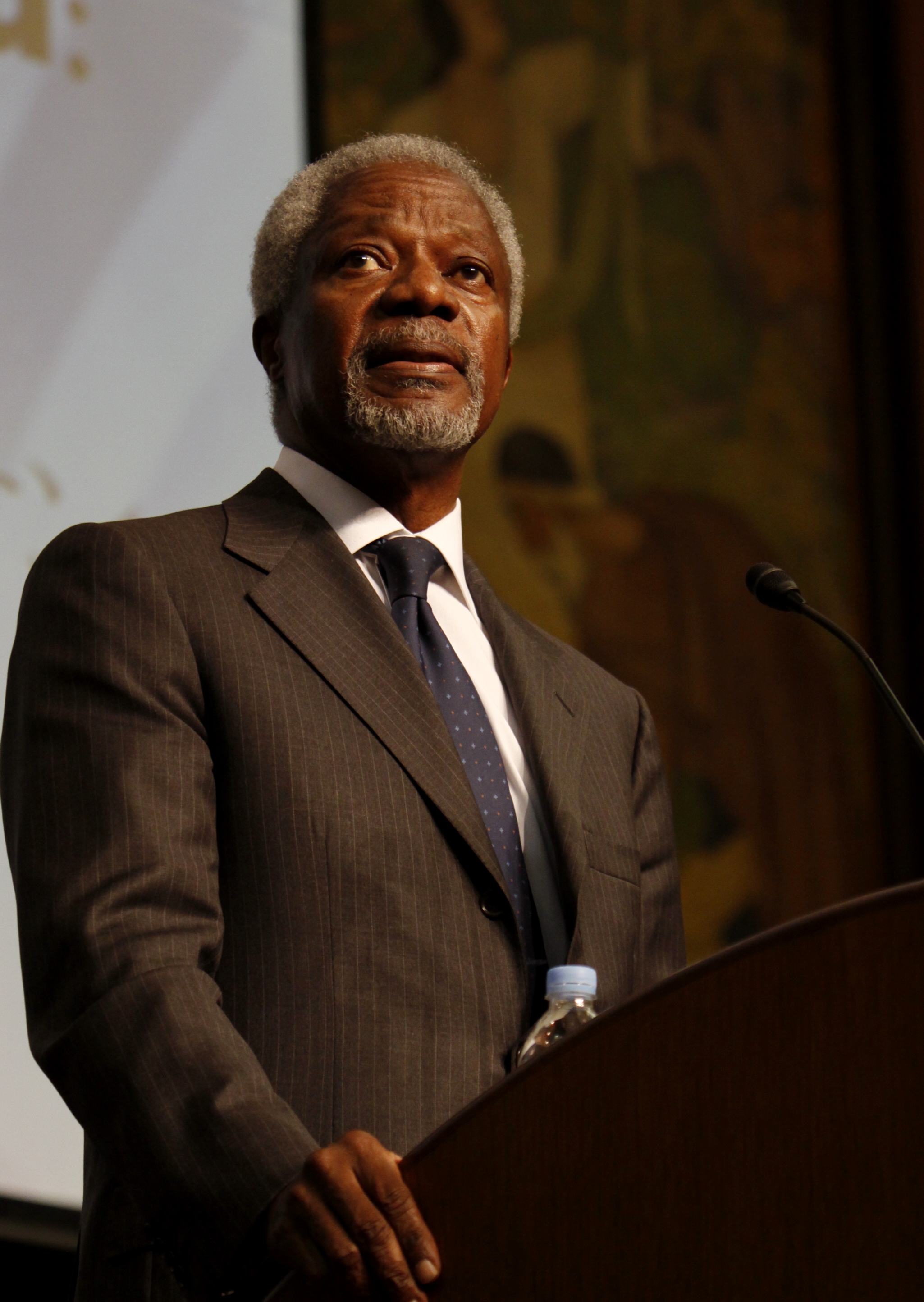Make or break: How the city of tomorrow will shape our future
This speech was originally given by Kofi Annan at the Langenburg Forum on 8 June 2017.
Cities are all about people. They are home to 50% of the world’s population, yet cover only 2% of our planet’s surface. They consume 75% of our power and are responsible for 80% of C02 emissions. It is where wealth is created and where social progress is often first imagined and fought for. Cities of the future need to be conceived around people rather than around cars and roads. They need to be made sustainable with regards to energy consumption and C02 emissions. If we fail to transform our cities, we will fail to meet the targets set out in the sustainable development goals. And if we fail to support the cities of the development world, especially of Africa, the young and able will continue to migrate to Europe for a brighter future. It is on the city of the future that we must focus if we are to solve many of the world’s most pressing problems.
Cities have evolved over time. They usually reflect the economic production activities of their era. It is unsurprising that in the era of fossil fuel, most were built around the car. Before the industrial age, cities had a simpler lay-out. Further back in history, people would cluster around a source of water. The size of that settlement was the distance you could walk carrying a pot of water from that source of water back to your home. With industrialisation, cities started being built around clusters of production, of living, of education and of healthcare. Factories moved to the outskirts of cities and needed to be connected to residential areas so people could get to work. People also needed to be connected to schools and hospitals. Roads and railways were built to enable people to travel to and from destinations and so emerged the vast urban sprawls that characterize our cities today. The model was as simple as it is unsustainable: Build large roads and large Co2 spewing vehicles to travel on them. We did not systematically invest in environmentally friendly mass transportation systems. This is our world today.
The result are concrete urban jungles such as Los Angeles, Mexico City, or Jakarta with their punishing traffic. The air quality in many of these cities is so bad that the adverse health effects alarm public health officials around the world. Air pollution in Beijing has made headlines in recent years yet in China alone over 300 million people will move to cities in the next 15 years. That is the equivalent of the entire population of the United States. Many of these newly created and rapidly growing mega-cities are built after models invented in the 1950s and 1960s.
Migration towards cities is unlikely to stop anytime soon. It is in cities where most wealth is created. It is in cities where women, especially in the developing world, have found opportunities that they are often denied in more rural areas. Those are the reasons why cities continue growing so rapidly.
By 2050, roughly 70 percent of the world’s population will live in cities, an influx of 2.5 billion people. So let us look to the future. The advent of new technologies is giving us glimpses into opportunities to re-imagine our cities as green, clean and sustainable spaces conceived around people. For instance, we observe that work is becoming more mobile and office buildings are losing their primordial status as many people work from their homes. The home in general is gaining more importance as it becomes a space of work, shopping, even healthcare. Fewer people are therefore forced to engage in tiresome and polluting commutes.
One of the most important changes will occur in the transportation sector: Driverless cars will, in a matter of a few years, become the norm and the debate will switch from: Should driverless cars be allowed on our roads? To: Should humans be allowed to take control of the wheel at all? The inevitable ascent of driverless cars will remove about one third to half of all vehicles from city streets. And few of those remaining cars will need parking space as they will continuously pick up and drop off people. People will be able to reclaim space taken up by cars today. Streets can be converted to pedestrian zones and parking decks can make space for parks. Many delivery vehicles will be replaced by drones. Traffic lights will become obsolete, so will many traffic signs. You can imagine the impact these trends will have on the physical lay-out of our cities and the opportunities that lie therein.
But the opportunities extend beyond the physical layout of our cities affecting our societies’ social fabric. The disabled and the elderly will regain a greater sense of independence through greater mobility. Think about the benefits for the blind. Commuting times will be drastically reduced. Architects, urban planners, engineers and car companies are already harnessing the potential of these new technologies and creating smart, energy efficient homes and clean cars. They are conceiving urban spaces that cater to people, with parks and bike lanes. They now have the technology to design environments that cater to people and their needs as well as to the needs of future generations.
But all these new technologies are nothing without policies from our political leaders that provide an adequate framework that puts people first. Innovators in Silicon Valley, or elsewhere can find the answers to many of our questions: How do we reduce pollution, noise, and distances? How do we find space for bike lanes, parks, pedestrian walkways and rivers? Our job as policy makers is to ask the right questions that channel the progress made, and result in socially and ecologically advanced sustainable urban centres. Let us articulate policies and laws that focus on children, the elderly, the disabled, women, families, and workers.
The technologies are developing rapidly, but are we, as societies having the debates that are necessary? Are we asking tech companies the right questions and giving them the right policy frameworks? The Sustainable development goals have given us a very broad and overarching framework. Cities need to think hard how they can comply with the targets the SDGs set. But this framework is broad and not designed to guide our use of technology to create cities for us and for our children. We as politicians, corporations, and civil society need to come together to decide the type of space we wish to create for the urban society of the future.
So let us look towards the many rapidly urbanising rural societies of the developing world. Those countries have the incredible opportunity to leapfrog and bypass the city of the fossil fuel era. They can build the infrastructure with clean technologies of the 21st century. In Africa, the way urbanisation will be managed over the next decades will determine the fate of the continent. At best, urbanisation will be the engine of economic development and at worst result in densely populated poverty traps fermenting political and social unrest. In Africa, urbanization will proceed six times as fast in the next few decades as in the past century. Like Europe in the 19th century, many African countries are still largely rural with only 20% of the population living in cities. This is changing rapidly: Half a billion people will have moved to cities by 2050. Building cities able to accommodate half a billion people over the next 30 years is one of the biggest transformations of our planet and we have to get it right. To get it right, the African city of the future needs to completely change its urban planning. Up until today, rural populations moved to cities without any planning, infrastructure or public policy to speak of. The result are slums and shanty towns. Rather than producing wealth and business opportunities, these poverty traps produce disease, crime and violence. Since these cities fail to function as centres of productivity, no wealth can trickle to countryside. That way entire countries remain trapped in poverty. The consequences reach far beyond African borders as the youth look for a better future elsewhere. Over the coming decades, the impact on Europe, already struggling with migration, will be hard to overstate.
So what needs to happen?
Successful cities are built on 3 vital ingredients right: People invest in houses. Companies invest in factories and commercial property. Government invests in infrastructure. The sequencing in which this happens is the clue. Rather than repeating the mistake of waiting for people to move first and build slums, governments need to move first providing infrastructure. Building infrastructure ready to absorb half a billion people, however, is no small feat. It requires far-sighted planning. It requires investment in transport systems, housing, clear cut land rights and financial instruments to finance it all. The know-how and the resources need to be made available now. It is much more expensive and cumbersome to provide infrastructure retro-actively, to clarify land disputes retroactively and to contain disease and crime retroactively. Millions are doomed to remain poor unless the African city of the 21st century becomes a success story. Let’s help Africans to leapfrog the fossil fuel city of the 20th century and build clean, sustainable, and wealth producing urban centres.
Even if the challenges are different, both in Africa and in Europe we urgently need smart laws and policies that help us reap the rewards of social and technological advances while containing the risks. The fate of our continents is, to a large extent, bound together. We are all in the same boat.



